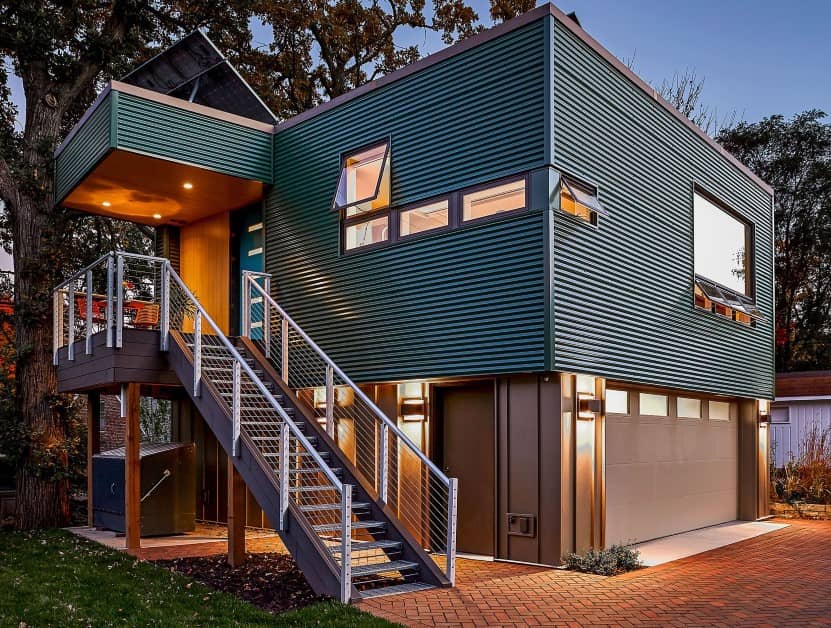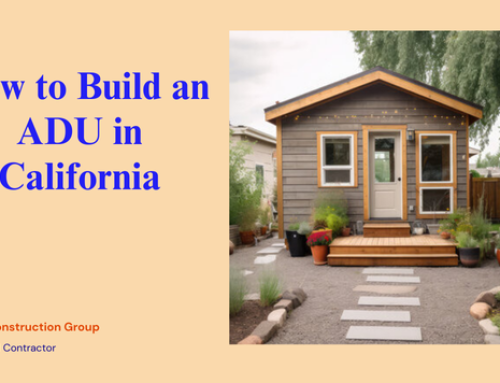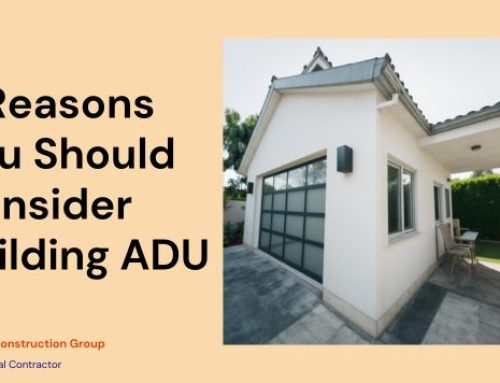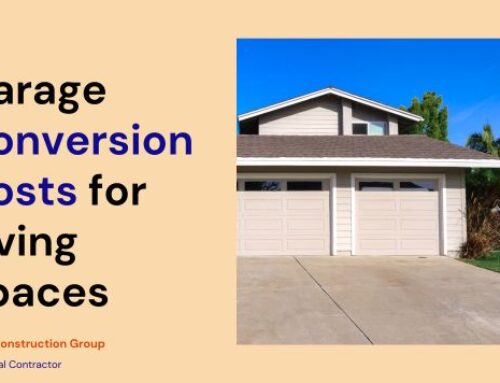As the name implies, an ADU (accessory dwelling unit) is a smaller, independent residential dwelling unit located on the same lot as its owner’s primary residence (i.e., a detached single-family residence). In the United States of America, accessory apartments are also known as secondary suites or granny flats.
In addition to their conversions from existing homes (internal ADUs), attached ADUs can also be added to new or existing homes (attached ADUs), or they can be built as independent units or converted from existing standalone accessory structures (detached ADUs). Additional dwelling units are housing units that are constructed on a secondary living space on an existing residential property.
Generally, ADUs should be smaller in size according to California’s state law. The ADU size limits in Los Angeles range from 150 to 1,200 SF. 1,200 SF is the ADU maximum size and 150 SF is the minimum size. These tiny spaces must have all amenities required for a tenant to live comfortably, including a kitchen, bathroom, bedroom, and a completely separate entrance from the main unit.
Over the pandemic, many people moved back home and found that ADUs offered a private space to work from home and socialize with friends away from their families. According to Freddie Mac’s report, the number of ADUs in the United States rose to 7%, up from 1% almost two decades earlier, indicating they are in high demand.
Junior Accessory Dwelling Unit
A junior accessory dwelling unit is a small dwelling unit built inside existing single-family homes. The size of a JADU may reach 500 square feet. A JADUs can be created by adding an exterior door and a small kitchen to an existing single-family home.
In other words, JADUs is a powerful tool if you’re thinking about converting a room of your house into a potential rental unit for extra income or to house a family member.
Types of Additional Dwelling Units (ADUs)
There are different types of ADUs, each of which are offering various benefits to families and their tenants. Let’s take a look:
| ADU Type | Definition |
|
Garage ADUs |
Garage ADUs or ADU garage conversions are an excellent alternative when living space is limited. In garage ADUs, existing garage space can be converted or a second level can be added above the garage. The ADU garage conversion cost lies between $60,000 and $350,000. |
| Detached ADU | The detached ADU is the most popular and widely used unit. As the name suggests, it’s basically a standalone dwelling with separated units but should be in the same shared living space used as a primary residence. If the main concern is privacy, a detached ADU is the most suitable vote. |
| Attached ADU | The attached ADU is a small unit attached to the primary housing structure. By adding extra space to the existing primary dwelling, the space becomes suitable for the occupancy of family members. |
| Internal ADUs | The internal ADUs are similar to the attached ADU, which are constructed within the existing floor plan of primary housing, including building upstairs ADU or Basement ADU. Upstairs ADUs are constructed within an existing upper level or on a second-floor addition, whereas Basement ADUs are constructed within the basement level of the primary home. |
ADU Ordinances & Requirements in Los Angeles
California’s legislature finds that allowing accessory dwelling units in single-family and multi-family zones provides extra rental housing and helps solve the state’s housing shortage. Listed below are the essential ADU requirements and recommendations from Senate Bill 13, Assembly Bill 68, Assembly Bill 670, Assembly Bill 881, and previous ADU legislation.
- Limits on ADUs: Junior ADUs are restricted to 500 SF and must be entirely contained within an existing or proposed single-family house. Whereas, an ADU must have a minimum living area of 150 SF and can be up to 1,000 SF This can be 1,200 SF if detached. Unrestricted ADUs can be up to 800 SF and are also limited to 16 feet in height if detached. Attached ADUs can be up to 800 SF or up to 50% of the primary residence area without exceeding 1,000 SF.
- Height Limit and Property Line Setbacks: A single-story ADU can only be 16 feet tall with a 4 feet setback on the sides and back. Whereas, the height limit and setback requirements for a two-story ADU are determined by municipal legislation.
- Lot Requirements and Coverage: There are no minimum lot size limits or coverage limitations.
- Utility Costs For Conversions: New or separate utility connections and fees are not required when ADUs are installed within an existing structure.
- Mixed-use and Multi-Family Zoned Properties: Up to 2 new construction ADUs (attached or detached) are allowed. You may add up to 25 % of existing dwelling units by converting non-livable space within existing multi-family structures with a 4 feet setback and a 16 feet maximum height.
- A separate entry/egress.
- A kitchen with a sink, cooking appliance, counter surface, and storage cupboards.
- Sleeping area.
- At least a 3/4 Bath and bathroom facilities.
- A living area of at least 150 square feet.
- ADUs are classified as part of the single-family dwelling for fire and life safety legislation.
- Fire sprinklers will not be required in ADUs if they are not required for the principal dwelling.
ADU ordinances and zoning exemptions must be available to individuals with disabilities. People with disabilities may be able to get a variance from the rules regarding setbacks, parking limitations, and approved uses in the development process.
Read More: ADU Garage Conversion Requirements in Los Angeles
Who Can Build an ADU?
According to the Los Angeles ADU ordinances, small tiny houses are allowed in residential zoned spaces regardless of the average size of ADU. If the structure meets the basic requirements and has an existing space, you have the opportunity to build an ADU on your property as a LA homeowner.
Multifamily properties, such as duplexes, triplex, four-plex, and apartment buildings can build ADUs. But, these properties have distinct ADU construction guidelines and build several ADUs on a single property.
Is It Worth Building an ADU in Los Angeles?
The home values of California remain high. The year 2020 was big for ADUs and other affordable housing types in Los Angeles California. Even several crucial laws were passed at that time to remove obstacles to the ADU development process. Thanks to these ADUs’ regulations, homeowners across Los Angeles, started investing in ADUs for age-in-place housing, or as income from short-term and long-term rentals. And, it has become easy to add ADU properties to existing ones.
So, Yes! Like most home improvement projects, you can see a big rise in your home’s resale value after building an ADU. An ADU may be appraised differently if it is viewed as a rental property or as a second home. In general, an ADU can add $200,000 – $500,000 to the value of your property in California, which is an incredible return on your investment.
It’s necessary to maintain two spots for the existing residence when converting an existing garage into an ADU, which could be side-by-side or in tandem. If the accessory dwelling unit is attached to the existing house or garage, then it must be at least 10′ away. As well, a new unit must be at least 4′ from each side and rear property line. But, garage conversion into a living space doesn’t need to meet these setback requirements.
Overall, an ADU is likely to give you a great return on investment. According to Porch Survey, In America’s biggest cities, a home with an ADU is priced 35% higher on average than a home without one.
Things To Know Before Investing in ADUs
Are you planning to build an ADU? Here are the following things you need to consider for investing in building an ADU in Los Angeles.
Determine Local Zoning Codes
Each area or zone has its own specific rules and regulations for building an ADU, which are typically governed by the local government. That’s why it’s necessary to discover your city or state’s ADU building rules for understanding the process before moving to further steps in projects.
Have Design Plans Before Buying
Before investing, make sure you have design plans in mind, including confirming designs meet city codes. Moving too quickly could lead to wasting money or hefty fees in some areas due to the strict size of ADU and set-back policies. When it comes to building ADUs, the last thing you want is to find you’re halfway done with a product that doesn’t meet regulations.
Make a strategy before you start construction rather than assuming everything will work out on its own. Ensure that you understand the regulations related to ADUs and their rules. In addition, determine the ADU construction cost for getting an idea and planning out other expenses.
Aware of California ADU Laws (2023)
As we have discussed above, there are multiple ADU building regulations, which are sometimes burdensome for local homeowners to understand. To handle the current housing crisis and encourage the building of new units to meet the demand, the State of California recently has come up with some laws that help remove some of the local obstacles and streamline the process. Below are a few 2023 updated key laws to be aware of as a potential investor of an ADU.
SB-13 (Owner-Occupancy Prohibitions and Fee Limitations)
In the years before 2020, local laws require the homeowner to live in the primary residence before an ADU can be built. Through January 1, 2025, SB-13 removes that restriction.
The construction of ADUs smaller than 750 square feet was often burdened with impact fees in addition to occupancy laws. It’s now required for local agencies to set their fees based on the square footage of the property.
AB-670 (Homeowner Associations Limitations)
If you live in an HOA community with strict Covenant, Conditions, and Restrictions (CC&Rs) that make the construction of an ADU inaccessible, you now have the option to invest in an ADU. As a result of AB-670, HOAs are prohibited from restricting the construction of ADUs on single-family residential properties that meet all of the necessary regulations and are zoned for single-family residential use.
AB-671 (Local Government Assistance)
AB-671 is perhaps one of the most important new laws. As a result of the law, local government agencies are required to provide a plan that promotes and includes incentives for low-income homeowners seeking to build an ADU as well as those who promise to rent out their ADUs to low-income households and individuals.
In order to assist with the costs, planning, and construction of Additional Dwelling Units, local agencies should provide information on grants and programs. Increased affordability and gentrification of urban neighborhoods are two benefits of these programs.
Hire a General Contractor
Many homeowners choose prefabricated kits or plans when building an ADU. It can be quite affordable to purchase these ready-made kits and architectural drawings rather than commissioning custom plans. However, these kits and plans do not comply with local county permitting laws. Even if homeowners purchase these plans, they must still customize them to meet local building codes. Choosing LUX Construction Group in Los Angeles which is familiar with the building process eliminates these redundancies, saving homeowners valuable time and money.
What Are The Prohibited Areas For ADUs?
ADU development is highly promoted in most areas of LA county. However, there are even some exceptions in some areas, and new ADU construction isn’t that much easy.
The first is designated Hillside Areas. In these areas, houses are built in the foothills and mountainous terrain characteristics of Los Angeles, which further presents unique challenges to homeowners. Not only construction is quite difficult in these areas but roads are narrow and winding through the hills, which makes the construction process difficult as the vehicles can’t get in and out of a site. This further can create safety issues.
Additionally, Hillside Areas are also prone to more natural disaster risks, including landslides and fires. Even these areas are unfavorable due to a more pronounced impact on sewage utilities, congestion, and parking availability. Due to such reasons, the Los Angeles ordinance restricts accessory dwelling units in Hillside Areas.
Moreover, you can’t even build ADUs in Very High Fire Severity Zones, which are designated by the City of Los Angeles Fire Department.
How Much Does An ADU in Los Angeles Cost?
Building an ADU will cost anywhere between $60,000 and $400,000 or more, depending on its size and design. This construction includes things such as building the fourth walls, adding the internal components, like walls, a kitchen, the bathroom flooring, etc, or installing windows and doors, electrical appliances, air conditioning, and heating.
Whereas, a case study has shown that two-story detached apartments with two bedrooms and 1.5 bathrooms were incredibly expensive at $661,585. It concludes that two-story ADUs cost between $100,000 and $700,000.
Do We Need ADU Permit in Los Angeles?
In Los Angeles area cities, and unincorporated Los Angeles County, homeowners need approval from their local department of building and safety to run project plans. Overall, more than 65 % of Los Angeles County is unincorporated. On the other hand, there are 88 incorporated cities within Los Angeles County, each with its own city council. The areas that are not part of these cities are considered to be unincorporated county territories.
For ground-up construction in unincorporated Los Angeles County, you need to submit plans, including detailed measurements and schematic drawings for the builder. And once the project is completed, homeowners have to obtain a certificate of occupancy before moving in. It means the structure will be inspected, including electricity, plumbing, and heating system to ensure that everything is in working order.
The ADU permit process in Los Angeles usually takes 3 or 6 months. Depending on your location in LA County, you can obtain a permit from the Los Angeles County Public Works Department.
So, how much do ADU permits cost? Well, the cost of an ADU permit ranges between $1,000 and $15,000 for a single person. But, this cost varies project by project.
LUX Construction Group: Los Angeles ADU Services?
Building an ADU isn’t the same as constructing a small house. That’s why it’s necessary to consult with general contractors while building an ADU in Los Angeles. The process of ADU is quite daunting, from planning to permitting and construction. In such cases, the ADU contractor you hire will protect and handle this long process. However, be aware of cost overruns and construction delays, so ensure that you hired an honest and trustworthy ADU architecture and contractor.
At LUX Construction Group, we assist homeowners in Los Angeles in building an advantageous ADU, so they can either use it as livable space or rent it out as per their choices. If you have any queries or want to ask something, please contact us!






